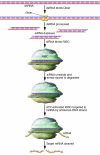On future's doorstep: RNA interference and the pharmacopeia of tomorrow
- PMID: 18060018
- PMCID: PMC2096464
- DOI: 10.1172/JCI34274
On future's doorstep: RNA interference and the pharmacopeia of tomorrow
Abstract
Small molecules and antibodies have revolutionized the treatment of malignant diseases and appear promising for the treatment of many others. Nonetheless, there are many candidate therapeutic targets that are not amenable to attack by the current generation of targeted therapies, and in a small but growing number of patients, resistance to initially successful treatments evolves. This Review Series on the medicinal promise of posttranscriptional gene silencing with small interfering RNA and other molecules capable of inducing RNA interference (RNAi) is motivated by the hypothesis that effectors of RNAi can be developed into effective drugs for treating malignancies as well as many other types of disease. As this Review Series points out, there is still much to do, but many in the field now hope that the time has finally arrived when "antisense" therapies will finally come of age and fulfill their promise as the magic bullets of the 21st century.
Figures

References
-
- Terui Y., et al. Expression of differentiation-related phenotypes and apoptosis are independently regulated during myeloid cell differentiation. . J. Biochem. (Tokyo) 1995;117:77–84. - PubMed
-
- Sawyers C.L. Research on resistance to cancer drug Gleevec. Science. 2001;294:1834. - PubMed
-
- Friedberg J.W. Unique toxicities and resistance mechanisms associated with monoclonal antibody therapy. Hematology Am. Soc. Hematol. Educ. Program. 2005;2005:329–334. - PubMed
-
- Casey B.P., Glazer P.M. Gene targeting via triple-helix formation. Prog. Nucleic Acid Res. Mol. Biol. 2001;67:163–192. - PubMed
Publication types
MeSH terms
Substances
Grants and funding
LinkOut - more resources
Full Text Sources
Other Literature Sources
Research Materials

